How to Stencil Tile Floors: A Cheap, Easy, & Lasting DIY Bathroom Makeover
Painting and stenciling our bathroom tile floors turned out to be the perfect quarantine project. Anyone looking to update their boring, 12x12 tile floors can save money by simply painting over them with a classic stencil design. Here's how to make them last!

This site contains affiliate links to products. We may receive a commission for purchases made through these links.
By now, you have likely seen Pinterest tutorials on how to paint and stencil tile floors. Anyone looking to update their boring, 12x12 tile floors can save money by simply painting over them with a classic stencil design.
You might also recall my post last year about stripping our home’s tile floors and converting to stained concrete. After that feat, the only tile remaining is in the bathrooms where tearing it up with a jackhammer really wasn’t feasible.
To save on time and money, I decided to paint and stencil the bathroom tile floors instead.
Although mine was completed in several stages, this budget-friendly, DIY renovation method can definitely be completed over a weekend.
This update turned out to be the perfect COVID quarantine project for my master bathroom. I still have quite a lot to do before my bathroom makeover is finished. However, working from the ground up, literally, seems to be the most efficient strategy.
But while most people stick with two solid colors, usually monochromatic, for their stenciled tile floors, I decided to be a bit different. I just can’t help it sometimes!
Taking my inspiration from Morocco (of course) and my Portuguese heritage, I ordered a variety of six 12x12 stencils and collected paint swatches from Home Depot.
Before we get to that part, let me preface that even if you do prefer a traditional design and color scheme, there are a few practical tips to bear in mind to ensure your hard work isn’t wasted on your stenciled tile floors.
Decisions, Decisions
Once you’ve designated a room, you can strategize when and how you will knock out your project.
For instance, my master bath is not a perfect square. There’s a separate toilet room that sets at an angle to the rest of the bathroom. My walk-in closet is only accessible by traipsing over the bathroom tile from my bedroom.
Thus, the less amount of time these tile floors were “off-limits,” the better, ideally.
The keyword there is ideally. But I live in the real world where my best laid plans and good intentions often end up staying plans and intentions.
Such is life!
Anyway, the next decisions needed to stencil tile floors are stencil pattern(s), paint color(s), and finally, the materials you’ll need.
Total List of Supplies (in order of use)
- Cleaning supplies (vacuum/mop/wipes)
- Painter’s tape
- 1 gallon Rust-oleum’s base coat (tint optional)
- Paint tray
- Standard 9-inch ¾ thick paint roller
- Plastic stencil design(s)
- Large pack of craft sponges
- Paint for stencil design
- Practice sheets (cardboard, artist paper, etc.)
- Knee pads (cannot stress this one enough!)
- Wet rag for mess-ups
- 4-inch smooth surface paint roller
- Eco-Tuff Clear Coat Sealer
- A lot of patience 😊
How to Stencil Tile Floors
Before stenciling can begin, your tile floors need a base coat. Most people choose a shade of white as their solid color, but I’ve seen some unique renditions with charcoal or navy as the primary layer, too!
Regardless of your tint, the type of paint you choose is extremely important.
Rust-oleum now offers a base coat specifically designed for all sorts of interior floors. Since it acts as a primer and grips tile surfaces, this base coat eliminates the need for sanding or additional priming!
Just one gallon of this stuff covers about 400 square feet. Depending on the color of your original tile, however, more than one coat might be necessary for complete coverage. We ended up painting two layers.
Like any paint, Rust-oleum’s floor coat is found in the paint and stain section of your local hardware store and can be tinted at the paint counter with any shade you select.
I went with Behr’s Polar Bear in enamel sheen for a crisp base.
The dry time on the base coat is approximately 6 hours, according to the paint can. I’d wager it was even less for my master bath with all fans running.
First Steps
My husband and I plan to redo all baseboards as well as repaint over all the drab, “Arizona brown” walls in our home. Part of our overall bathroom makeover will also include an updated vanity, so we didn’t bother taping off any surrounding surfaces before painting our bathroom tile.
Another important thing to keep in mind is that this base coat (and the top coat you’ll add when all is said and done) doesn’t work well with existing caulk. The brand recommends ripping all of this up if it’s in an area you’re trying to cover. For my purposes, it was fine as is since we’ll be redoing all of that later anyway.
Basically, as soon as we vacuumed and mopped our tile floor squeaky clean, we were ready to paint!
Maybe this is a Captain Obvious statement, but you’ll want to start painting your tile from the furthest corner of the room, working your way toward the entrance to avoid cornering yourself.
If you are painting a bathroom, note that the small space around and behind your toilet is going to be the trickiest. If your 9-inch roller doesn’t fit, have a small 4-inch roller on hand just in case.
Just like when painting a wall, don’t try to double coat your tile on the first round. Simply apply a smooth layer of base coat paint to the tile, overlapping your paint lines slightly. Be sure all grout lines are completely coated and that there are no air bubbles in these areas.
Once the first coat is dry, repeat with a second layer (or more, if needed).
A friend helped me paint my bathroom tile to completion on a Saturday.
As life would have it, however, the next free weekend I had to actually stencil the tile floors wouldn’t come for a couple of months…
Stencil Time
As always, Amazon has myriad stencil designs and sizes for a lot less than most craft stores. I’d ordered a pack of six 12x12 laser cut stencil designs with the original intention of choosing one to use as a repeat pattern across my tile floors.
Once I saw them, though, and laid them out across my floor in various patterns, I knew I wanted a more eclectic look.
I bought 11 different paint samples at Home Depot, all in either satin or enamel sheen. The associate at the paint counter may have developed a twitch by the time I left, but he was helpful and patient, nonetheless.
You might be wondering if it matters what kind of paint you use.
I did some research on this myself and came to the conclusion that since I was going to be finishing it all with a clear top coat, it really didn’t matter if I used an interior house paint or acrylic craft paint or some other type of paint.
So far, my theory has proven true.
Like most of my DIY house projects, I accomplish most tasks by trial and error.
Using some scrap paper, I immediately began practicing with the stencils and color combinations. I wanted to hone some form of technique on paper before applying to the tile.
Massive tip: I discovered a little bit of paint on an inch-wide sponge brush went a long way. Furthermore, dabbing with a sponge brush was easier and limited mistakes as opposed to using a roller or paintbrush.
At last, I said, “here goes nothing” and started in the far corner of my bathroom.
Lining up the stencil designs evenly on each tile proved more difficult than expected. I used painter’s tape to keep all four stencil edges secure.
Then, using a paper plate to remove excess paint from my sponge brushes, I blotted meticulously, holding down the inner stencil edges as I went.
Once all full tiles had been painted, my husband helped me measure and cut them to fit in the difficult, partial tiles like corners and around the toilet.
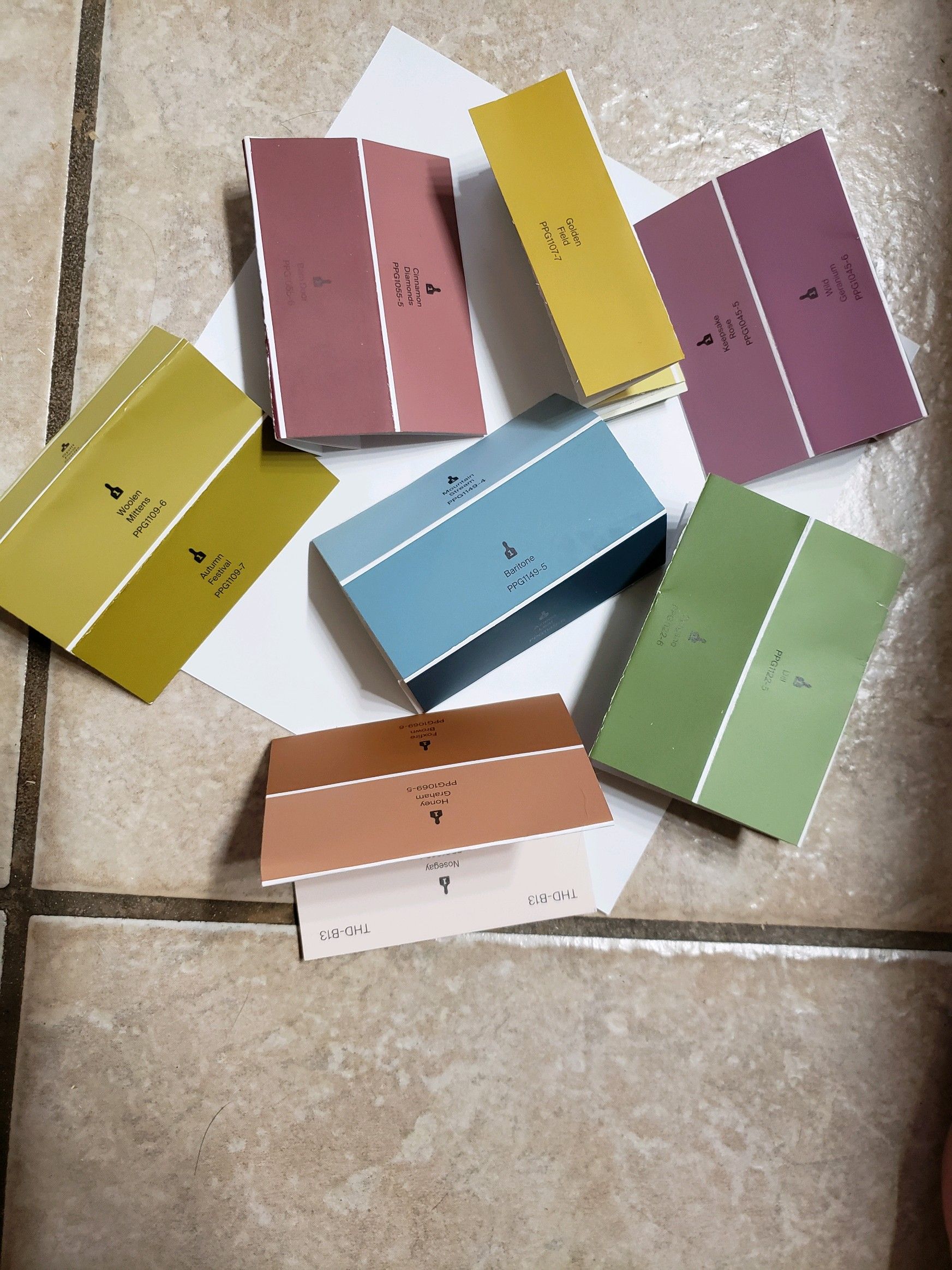



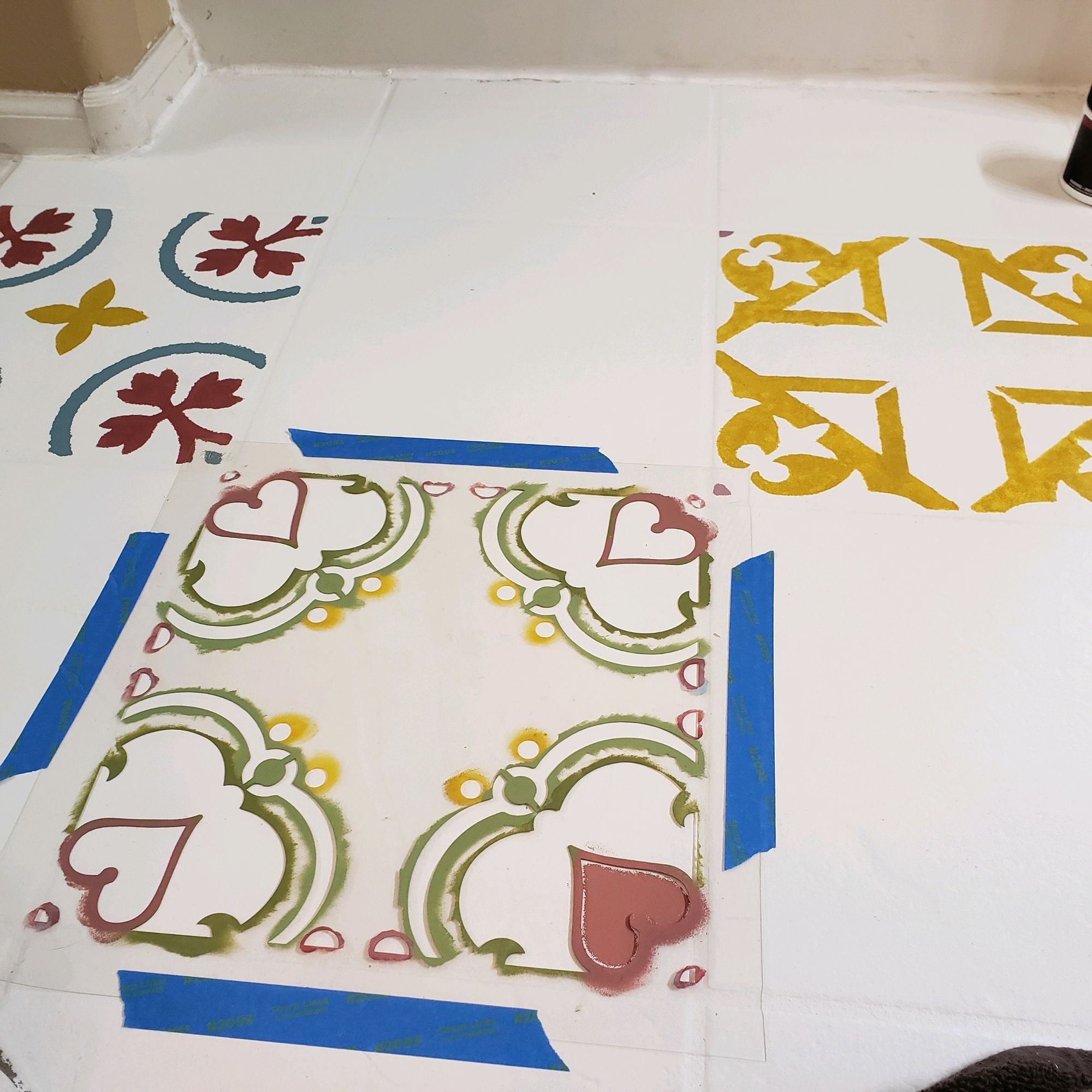
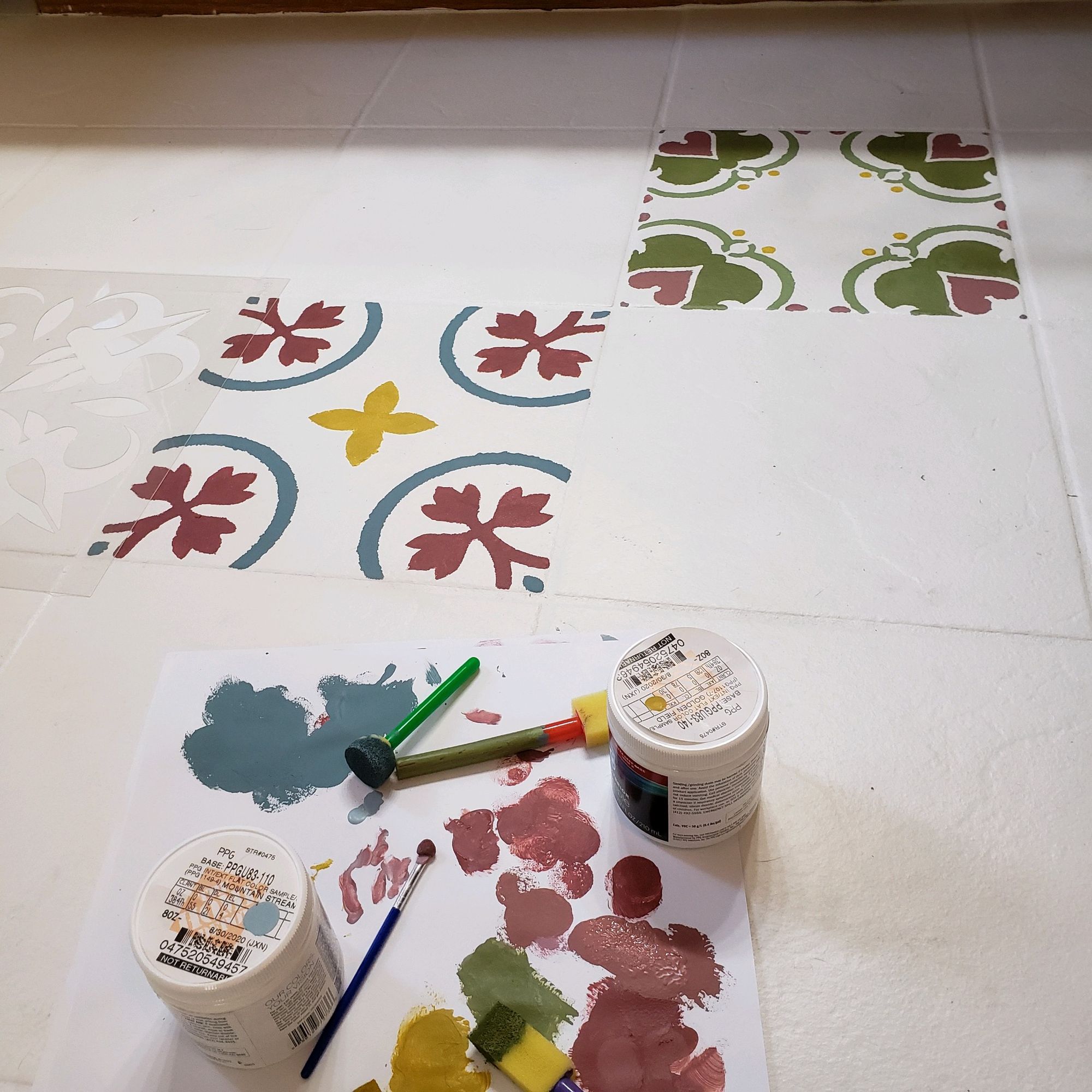
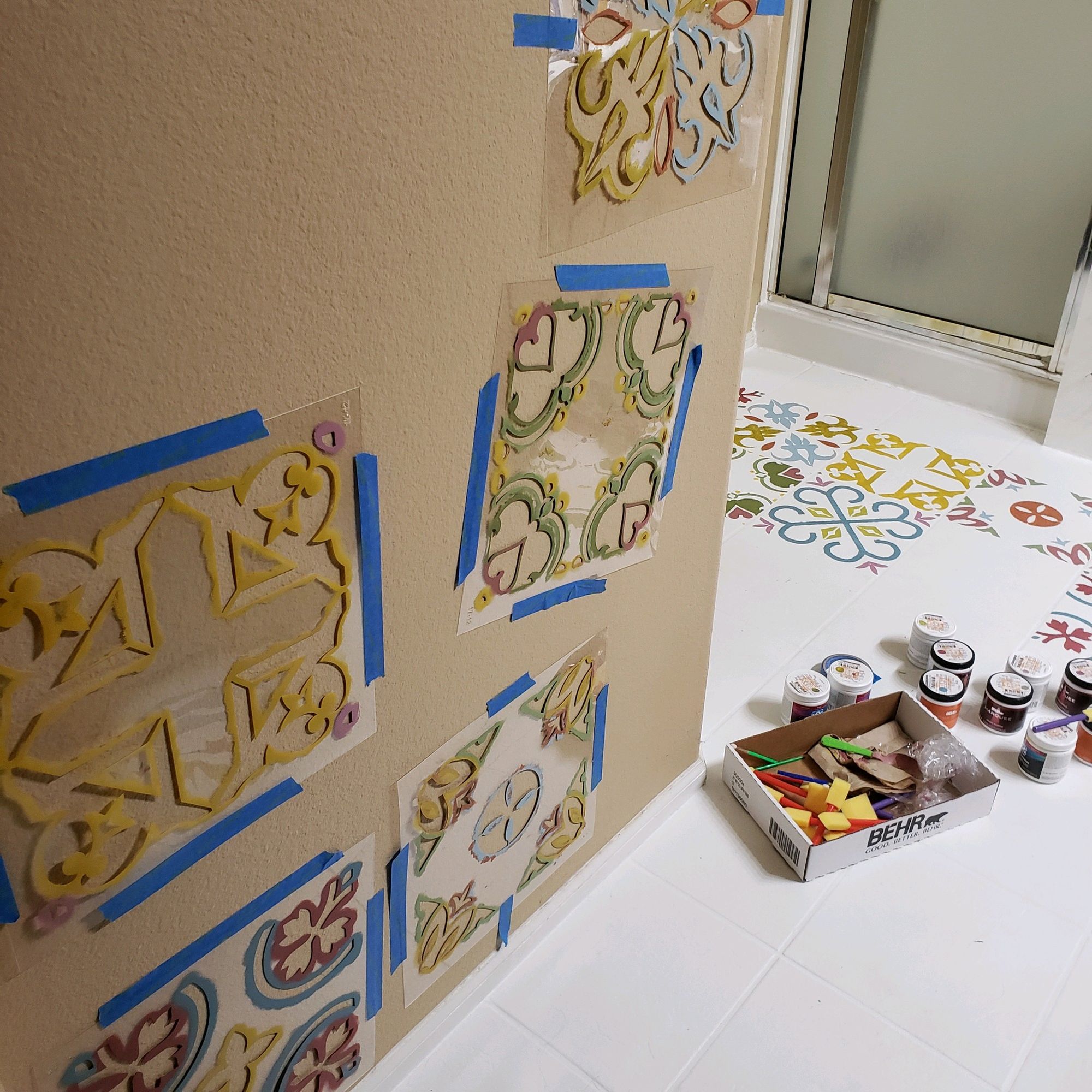
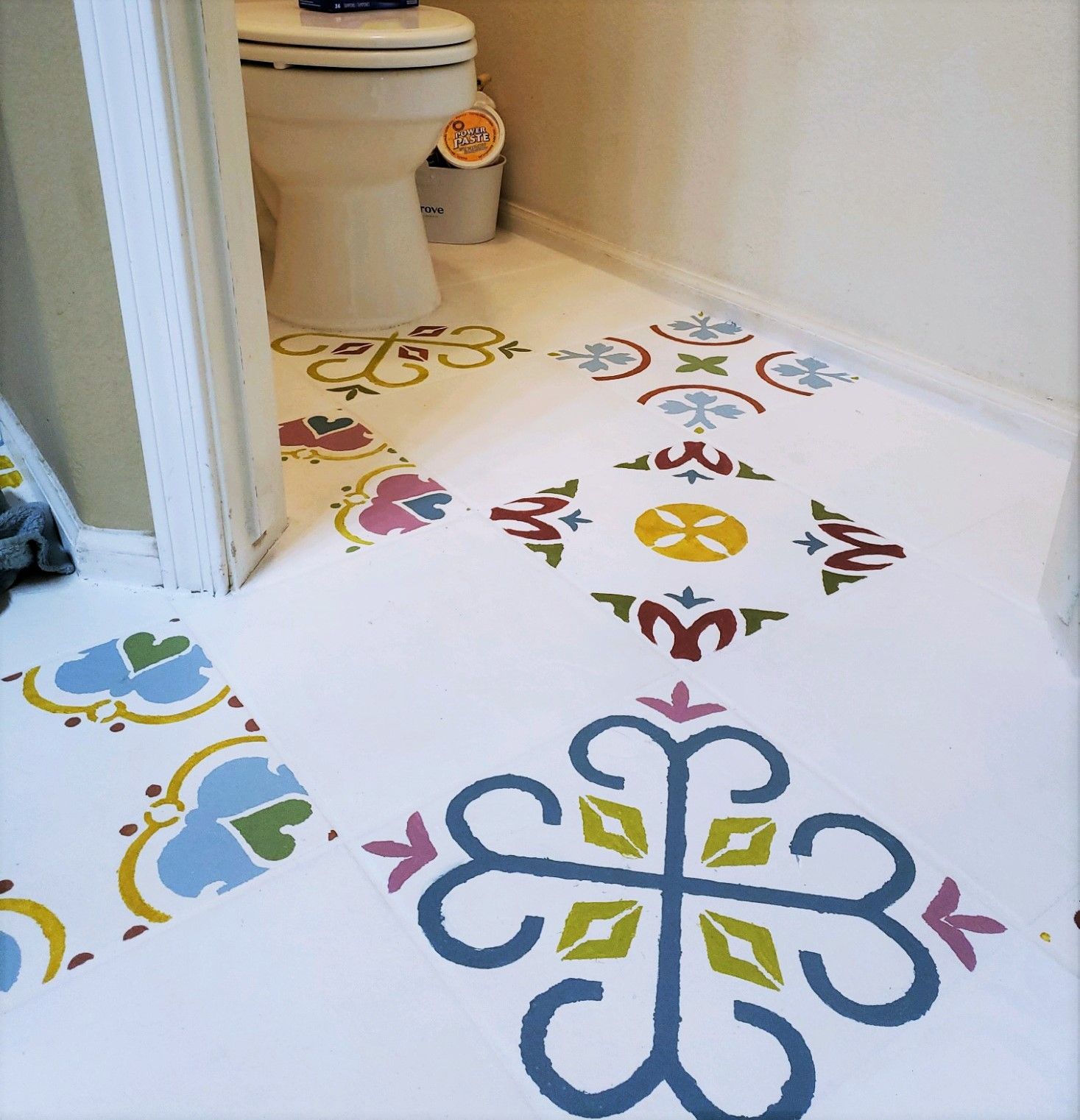
What I Learned About Stenciling Tile Floors
I’m not going to lie, using an eclectic mix of colors and mapping out each tile square was a long and painful process, both mentally and physically.
I found out real quick how painful this project was for my knees and lower back. Those bone bruises lasted a few weeks!
Please learn from my ignorance and slip on some knee pads. Or, in the very least, kneel on an old pillow or folded towel. Even if it takes multiple sessions, take breaks and stretch!
Remember what I said about trial and error?
Yeah, well, once I got on a roll, I ended up doing all six stencil patterns back to back on one row.
As soon as I stepped back, I knew it was too much. Too busy, too colorful, too tacky. I was already teetering on a dangerous limb with my multi-colored, multi-patterned selection, here, and I’d just made a grave mistake.
*Cue negative creative spiral*
After a deep breath, I calmly painted over every other tile, and completely removed one of the patterns that I decided I didn’t care for. Thank goodness for extra base coat!
Of course, because it was white, it took several coats to completely hide the unwanted designs. To anyone unaware, they can’t be seen, but I still know where they are…
Anyway, leaving some blank tiles and creating a diagonal pattern proved much more pleasing to the eye. All of the coordinating colors just make my heart so happy.
I let out many long sighs of relief!
Sealing Your Stencil Tile Floors
By far, this is the most important step.
Rust-oleum actually offers a clear sealant as part of the 2-step floor coating process. Sheen options include semi-gloss and matte. Generally, in areas of high natural light, less sheen is best.
A clear top coat is necessary to preserve your stencil tile floor design. This top layer acts as a shield from scratches and water build-up over time.
We happened to have a similar product in matte sheen leftover from whenever we installed and finished our butcher block island last summer. The Eco-Tuff clear coat has proven faithful on all surfaces thus far and I’m happy with its coverage, too.
For this step, you will want a 4-inch smooth surface roller. These specialty rolls allow for fine layers and reduce the chance of air bubbles and odd textures.
Before you start rolling, though, critique your floors for any small blemishes or stains you want to touch-up first! Once you seal your paint, it’s near impossible to strip it and fix what’s underneath.
Again, start in the far corner and work your way out, overlapping only slightly and rolling slowly.
If you want to double-up on top coat, go right ahead; it won’t hurt one bit. Just make sure the first coat dries first.
Give your freshly sealed stencil tile floors a full day to cure before stepping on it.
In the meantime, give yourself a round of applause! You done it!


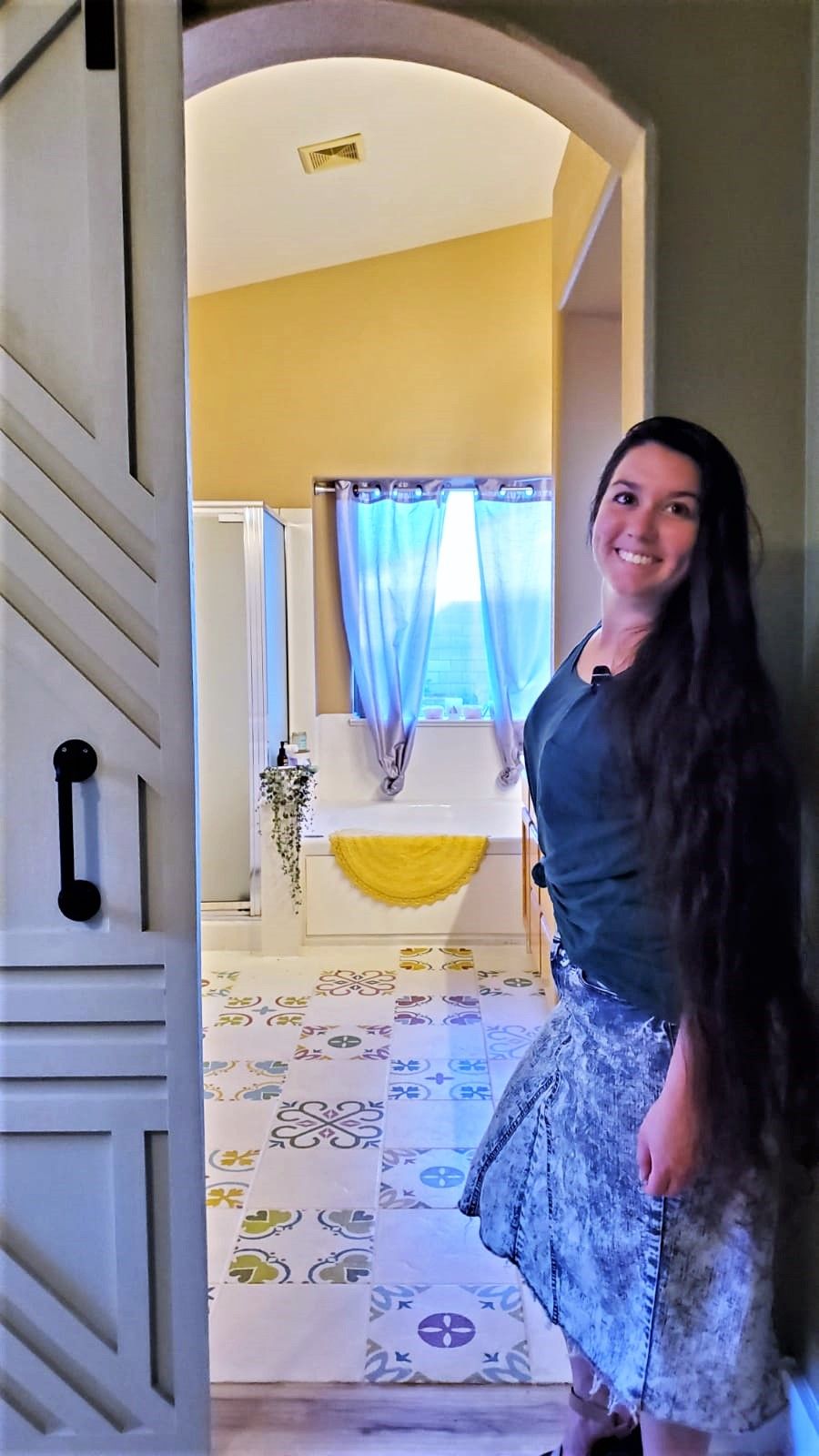
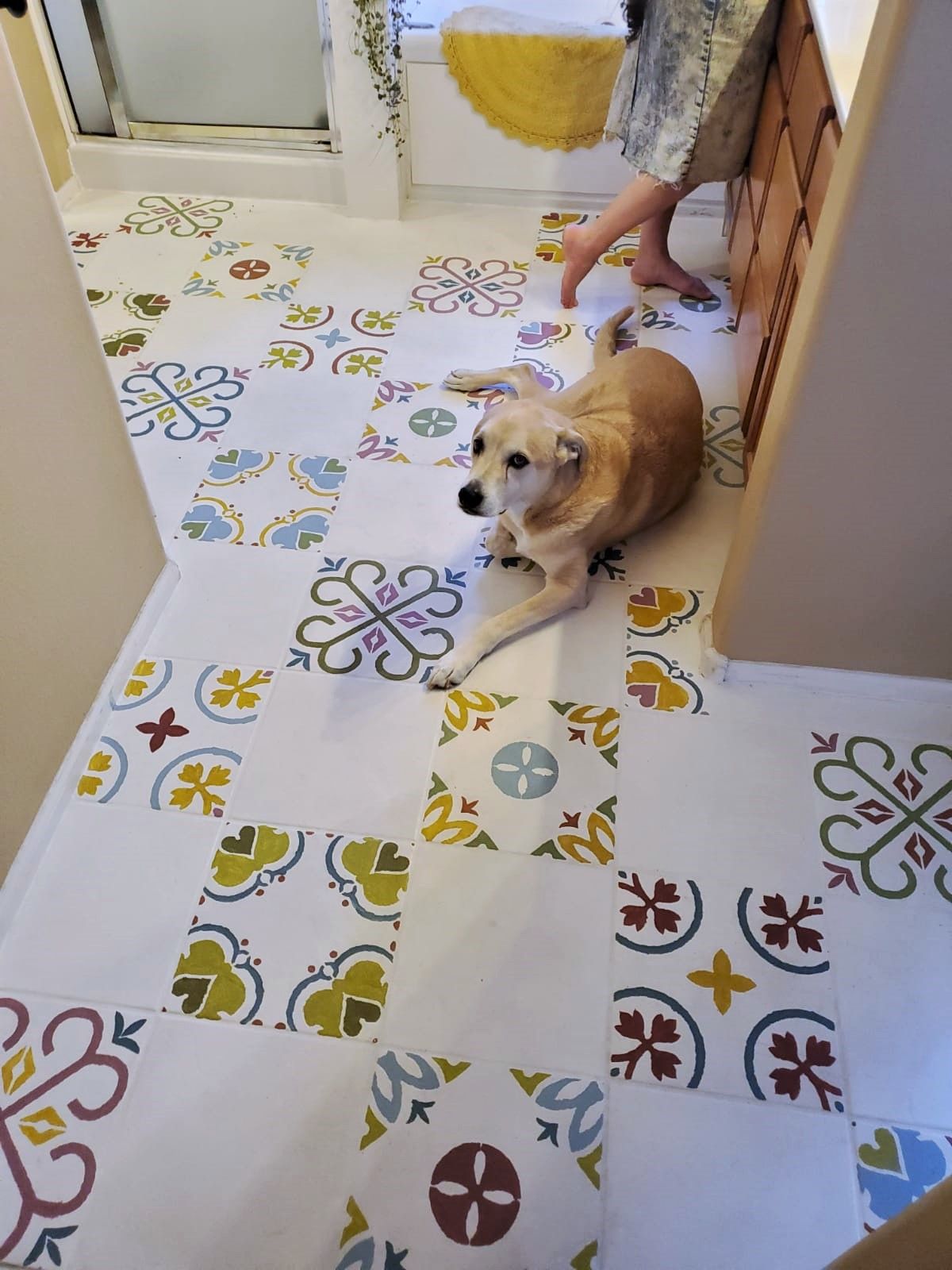
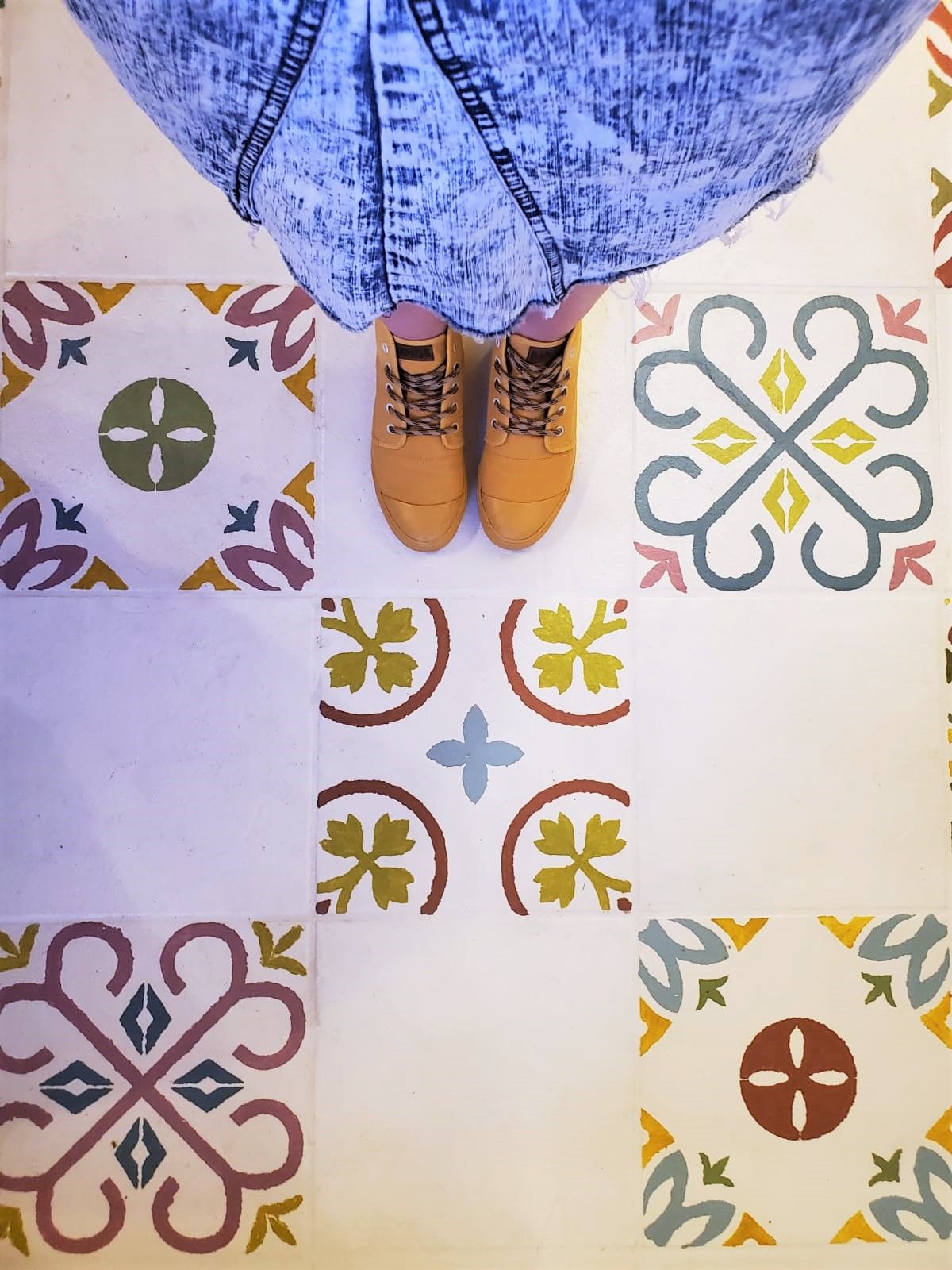


Final Tips for Painting and Stenciling Tile Floors
Although most of the mentioned products are low in VOCs, it’s still important to keep your working area ventilated. Open windows, run fans, and drink plenty of water while you work – getting a headache in the process is no bueno.
If you feel like being artsy fartsy by combining some of your colors to make a new one, great! I just advise using it all in one setting, as it could be really hard to recreate it.
I know most people won't share my enthusiasm for these colorful tiles that mentally transport me to Morocco. Had this room been a lot smaller, with shorter ceilings and less light, I probably wouldn't have opted for this eclectic style.
More than anything, I wanted to challenge myself to be creative. Besides, now I can pick pretty much any color I want for towels and other bathroom decor. I plan to keep the rest of the room fairly neutral, though.
As far as endurance, it’s only been 5 months since I stenciled the tile floors in our master bathroom. But with it being my dog’s main entrance to the backyard, Andrew’s and my walkway to and from our closet, and an area that gets a lot of moisture, the top coat has held.
Yes, scuff marks and paw prints will still show, but the clear coat makes it easy for them to be wiped up easily with everyday wipes and cleaning agents like our favorite Mrs. Meyer’s All-Surface spray.
I can’t wait to reveal our full bathroom makeover whenever the vanity is updated and the walls are freshly painted. The list of DIY home renovations isn't getting any shorter!
Until then, I’d love to hear whether you’ve attempted to stencil your tile floors, what color scheme and design you went with, and how they’re holding up for you!